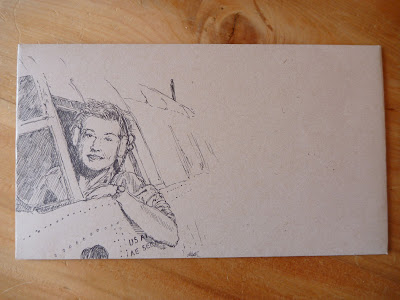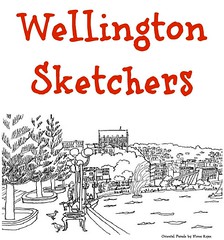I've been reading a lot about women pilots lately, being one myself years ago. I'm especially reading about women who flew in WW2 as ATA pilots, and also the Nachthexen Russian female pilots who actually flew in combat. I've also been wanting to do more envelope art. I thought I'd combine the two, and do some sketches of women pilots etc.
The front side is one of the ATA pilots, peaking out the cockpit window, just
before WW2. I know I have more details about the original publicity photo and the
pilot in it somewhere, but am having trouble finding it. I'll repost it
as soon as I do. I haven't put my penpal's address on the envelope yet,
as I don't want to post that on the internet.
In the original photo, the woman looked very young and was smiling more broadly. I didn't quite draw her this way. I've been reading how one in ten of the ATA (Air Transport Auxiliary) died, and how the women pilots had to prove themselves to be twice as good as the male flyers to be accepted as aviators. They often ferried the aircraft at huge personal risk, to get them to the combat pilots in dreadful weather and fog. They did this despite the fact that ATA pilots weren't taught to fly on the instruments (!!!) and radio navigation, like what we are used to using today, was not active over Britain because it would have helped the german attacking aircraft. The ATA pilots were so amazingly brave. I think this is the reason I subconsciously drew her having a more serious smile, and being a little tireder. I suppose when we look at those old pre-war publicity shots, we see them with the hindsight of knowing what the people in the photos had in their future.
In the original photo, the woman looked very young and was smiling more broadly. I didn't quite draw her this way. I've been reading how one in ten of the ATA (Air Transport Auxiliary) died, and how the women pilots had to prove themselves to be twice as good as the male flyers to be accepted as aviators. They often ferried the aircraft at huge personal risk, to get them to the combat pilots in dreadful weather and fog. They did this despite the fact that ATA pilots weren't taught to fly on the instruments (!!!) and radio navigation, like what we are used to using today, was not active over Britain because it would have helped the german attacking aircraft. The ATA pilots were so amazingly brave. I think this is the reason I subconsciously drew her having a more serious smile, and being a little tireder. I suppose when we look at those old pre-war publicity shots, we see them with the hindsight of knowing what the people in the photos had in their future.
The back side is Beryl Markham's signature Vega Gull plane, crashed in the mud after a ground-breaking trans-Atlantic flight. She was shaken and bruised, but luckily able to walk away.
When drawing illustrations on envelopes, it is important to cut the sidetabs and fold the envelope first. It is quite difficult to remember to draw everything in the right spot or alignment if you don't. You can see from the photo below how you have to leave a space along the edge for the tabs.
These sketches were just done on recycled paper, bought from the $2 shop. Much cheaper than buying envelopes. Here is my earlier post on how to make envelopes from A4 paper. I used an 0.05 black Staedler technical pen for both sketches.
Somewhere near Opotiki?, North Island, New Zealand




























